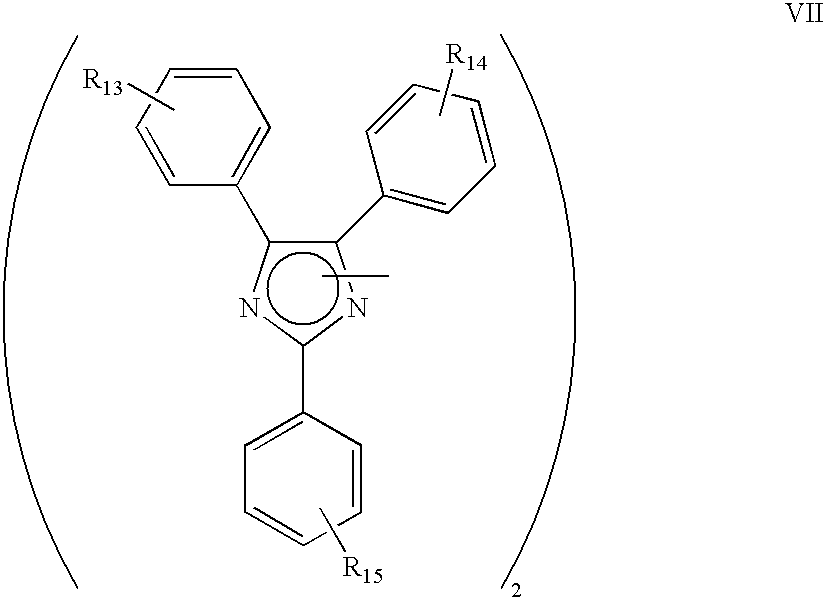Dry film photoresist
- Summary
- Abstract
- Description
- Claims
- Application Information
AI Technical Summary
Benefits of technology
Problems solved by technology
Method used
Image
Examples
example 1
[0100]To 2.1 parts of hydroxybutyl substituted benzil (0.01 mole) dissolved in 50 parts of glacial acetic acid containing 6 parts of ammonium acetate (0.078 mole) is added 1.4 parts of o-chlorobenzaldehyde (0.01 mole), and the solution is refluxed for 2 hours. The solution is then drowned in 200 parts of cold water whereupon 3.1 parts of reaction product precipitate. The product is isolated by filtration and purified by recrystalling twice from ethanol. The product, a chlorinated hydroxybutyl imidazole, is a white crystalline solid.
[0101]To 1.1 parts of the above prepared imidazole dissolved in 100 parts of ethanol containing 12 parts of potassium hydroxide is added 450 parts of a 1% by weight water solution of potassium ferricyanide at a rate of 5 parts per minute for 1.5 hours with continuous stirring. The oxidation reaction product in an amount of 1.0 parts precipitates from the reaction mixture, is isolated by filtration, and is washed with water until free from ferricyanide. Th...
example 2
Negative-Acting Dry Film Photoresists
[0106]The following ingredients are blended together in the given proportions to provide a negative-acting photoresist composition of the present invention.
[0107]
FormulationPercent byIngredientWeightAcrylic copolymer binder140Caprolactone 2 hydroxyethyl methacrylate5Trimethylol propane triacrylate (TMPTA)15photoinitiator containing compound25bis(dialkylaminophenyl) ketone0.04tris(dialkylaminophenyl) methane0.3aromaticsulfonamide3.5modifideacridine0.2Table Footnotes188,000-91,000 Mw copolymer of methyl methacrylate, methacrylic acid, n-butyl acrylate, Tg 90° C., 150 acid number.2Photoinitiator of Example 1.
[0108]A mixture is prepared at about 70% solids in 2-butanone and coated onto a 0.8 mil polyester carrier film and dried to approximately 1% residual VOC's. A thin film of about 1.5 mils thickness is obtained. The films are then laminated at 121° C., 40 psi, 1 meter per minute, onto chemically cleaned 1 oz. copper / 0.059 FR-4 / 1 oz. clad copper la...
example 3
A radiation curable solder mask composition is prepared in two parts as follows:
[0109]
PercentBy WeightComponent AEsterified styrene-maleic anhydride copolymer125.0Photoinitiator containing compound25.0Multifunctional (meth)acrylate37.5Pigment4.0Flow promoter3.5Anti-abrasion agent3.5Air release agent3.5Filler17.5Inert diluent10.5Component BMultifunctional (meth)acrylate325.0Multifunctional epoxy430.0Thermal cross-linking agent57.5Pigment / filler12.5Inert diluent25.01Pro 1100, Sartomer Co., Exton, Pa.2Photoinitiator of Example 13SR 351, Sartomer Co.4ECN1299, CibaGeigy Co. (Resin Division)5Dyhard100S, SKW Inc.
[0110]Component A and Component B are mixed, in a ratio of 3:1 at room temperature, and the composition so produced is screen-printed onto printed circuit boards using a 70 Durometer squeegee. The boards are then heat treated at 160° F. for various lengths of time to determine the operating window for pre-baking. The pre-baked boards are then subjected to development using a 10 g / L...
PUM
| Property | Measurement | Unit |
|---|---|---|
| Percent by mass | aaaaa | aaaaa |
| Percent by mass | aaaaa | aaaaa |
| Mass | aaaaa | aaaaa |
Abstract
Description
Claims
Application Information
 Login to View More
Login to View More - R&D
- Intellectual Property
- Life Sciences
- Materials
- Tech Scout
- Unparalleled Data Quality
- Higher Quality Content
- 60% Fewer Hallucinations
Browse by: Latest US Patents, China's latest patents, Technical Efficacy Thesaurus, Application Domain, Technology Topic, Popular Technical Reports.
© 2025 PatSnap. All rights reserved.Legal|Privacy policy|Modern Slavery Act Transparency Statement|Sitemap|About US| Contact US: help@patsnap.com



